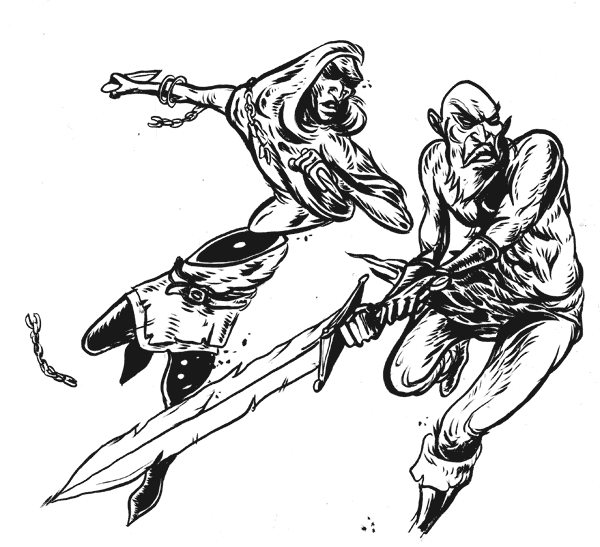Weapons
Weapon attacks to other players

By playing Weapon cards from your hand you can attack another Hero.
When a weapon is played check if you have any Monsters in front of you. If that is the case, refer to Weapon attack to Monsters.
Otherwise, roll a die to see how much damage will be inflicted: damage is equal to the roll of the die, modified by any +/- bonuses next to the ![]() Weapon card.
Weapon card.
Once any damage is inflicted on a player, move the Life Points counter down accordingly, keeping track of the player’s Life Points.
You can play any number of Weapon cards during your turn, repeating this method and inflicting damage (except for Heavy weapons).
In games with 3-6 players it is not always possible to attack any player or Monster, look in the Multiplayer section for further details.
Defence cards
If the defending player has any Defence cards in front of them the attack must be used to defeat the opponent’s Defence cards instead of reducing their Life Points.
If your opponent has multiple Defence cards, you choose the order the cards will be damaged before rolling the die.
If a Defence card suffers damage equal to the value next to the it is discarded, and the remaining damage is carried over to the next Defence card.
Any remaining damage will not affect your opponent’s Life Points (except damage done by Heavy weapons, see below.
Armour bonus
Every time damage is inflicted to a Player or a Monster with a defence bonus ( X ), damage is reduced by X after defeating all Defence cards in front of the attacked player or monster.
Secondary card effects
Some cards have secondary effects, indicated with text on each card, which will take effect after the primary effect is resolved.
If you play a card, using the secondary effect is mandatory and must be resolved, if possible.
Example: If the Hammer is played (secondary effect: “Remove a card from your hand”) as the last card from their hand then the player has no cards to remove and this effect is ignored. Pro tip: Play the Hammer last if you do not want to remove any cards from your hand.
Example: If the player does not have access to the Market during his turn (by having a Monster in front of him) then any Market effects are ignored.
Example: If playing a card with the “Discard a card” secondary effect on a Monster, the player on the left (or otherwise his opponent in a 3-6 player game) always discards, even if the monster/s are not his.
Remove a card
Some secondary effects state “Remove a card from your hand” or “Remove a card from the Market”.
To remove a card, remove it from the game instead of discarding it. Sold cards are also removed from the game.
If you ends up without any cards you are automatically eliminated from the game.
Example: If the Hammer is played (secondary effect: “Remove a card from your hand”) as the last card from their hand then the player has no cards to remove and this effect is ignored. Pro tip: Play the Hammer last if you do not want to remove any cards from your hand.
 It is useful to remove cards in order to optimize your deck and make it more efficient.
It is useful to remove cards in order to optimize your deck and make it more efficient.Discard a card
Some cards force you or other players to discard cards.
The card to be discarded is chosen by their owner, unless stated otherwise, and are placed face up into their owner’s discard pile.
In a game with 3-6 players, effects which make your opponent to discard cards, always target the player to your left, regardless of the target of the attack.
Example: If playing a card with the “Discard a card” secondary effect on a Monster, the player on the left (or otherwise his opponent in a 3-6 player game) always discards, even if the monster/s are not his.
Weapon attacks to Monsters
By playing Weapon cards from your hand you can attack the Monsters in play.
You are forced to defeat all Monsters in front of your Hero before attacking another player or Monster.
If you are attacking Monsters, roll a die to see how much damage will be inflicted: damage is equal to the roll of the die, modified by any +/- bonuses next to the ![]() .
.
A Monster is killed when it has no Life Points remaining, with wounds carrying over between turns: keep track of each Monster’s remaining Life Points by using a counter card provided or a die.
If you have multiple Monsters in front of your Hero, choose the order they will be damaged before rolling the die.
If a Monster card is reduced to 0 Life Points it is killed and discarded to its owner’s discard pile, and the remaining damage is carried over to the next Monster in the same area.
Any remaining damage after having defeated all Monsters in the same area is lost (except damage done by Heavy weapons.
When you kill a Monster, you gain its Market price in Experience Points (XP).
If you play a Weapon against a Monster, any secondary effect which targets your opponent is always applied to the player to your left (or otherwise to your opponent in a 5-6player game).
Heavy Weapons
Heavy weapons are indicated by an anvil ![]() .
.
Playing a Heavy Weapon is the only weapon you may play in a turn.
As opposed to non-Heavy Weapons remaining damage caused by Heavy Weapons is carried over and follows the following order:
1: Monsters in front of your Hero (if you are attacking Monsters, see here)
2: Your opponent’s Defence cards
3: Your opponent’s armour bonuses
4: Your opponent’s Life Points

